eCommerce has changed the way customers shop, and the internet is seeing a rapid increase in transactions. As one of the fastest rising eCommerce trends, voice search is certainly the hype these days. And as an eCommerce business owner, it’s something you cannot afford to lose out on. Going one step forward and making digital shopping easier are voice-enabled searches that are enormously popular and being used extensively for shopping online. Virtual assistants such as Amazon’s Alexa, Apple’s Siri, Samsung’s Bixby, Google Assistant, and Microsoft’s Cortana are a few examples of some great platforms that are exceptionally successful with voice queries. With the help of voice search, you can now order your groceries, call for a taxi, play music, and access any information you need.
72% of people who own voice-activated speakers use these devices as a part of their daily routine.
Voice-enabled shopping has seen huge traction in the past few years. With the rise of the products in the online markets, experts predict a further surge in the demand for voice-driven user experience. A forecast by the U.K. based analysts at Juniper Research shows that voice commerce will grow to reach more than $80 billion per year by 2023.
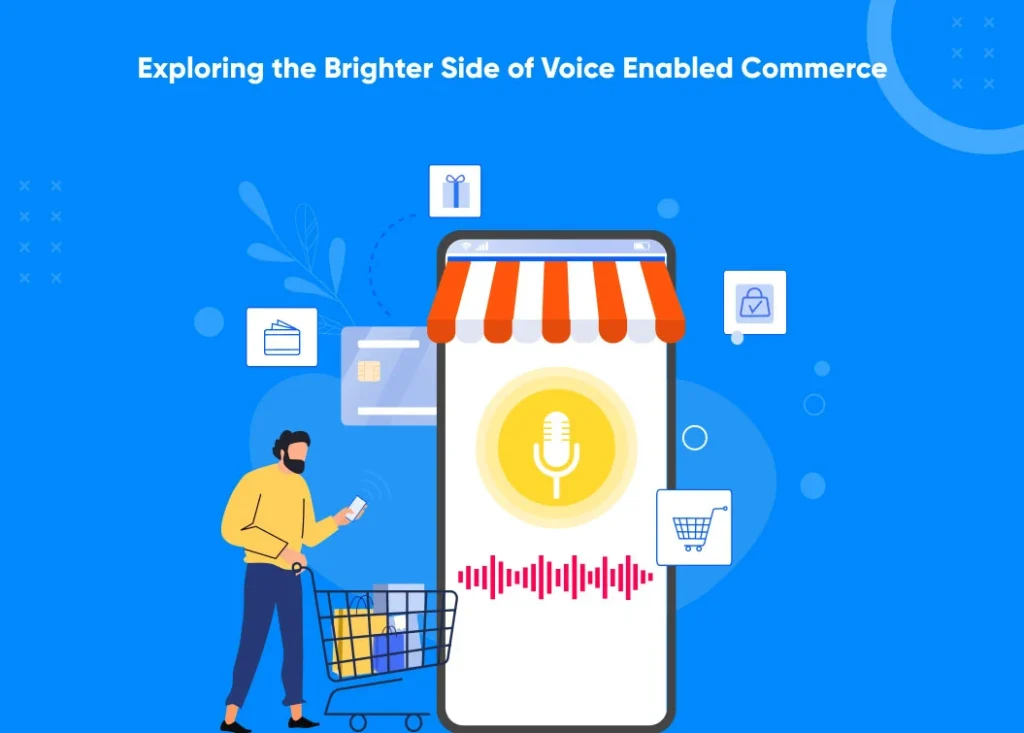
What is Voice Search?
Over the period, while our habit of getting instant answers has not changed, what has changed is our methods of searches and methods of solutions.
Voice Search is the digital action of using “speech” to search questions or give commands on the internet through digital devices like smartphones and tablets. The searcher speaks the requirements to the device, and the device acts accordingly, whether answering a question or fulfilling a demand.
Voice search is becoming a favored mode of communication since it reduces time and exertion as users don’t have to look for keys or type. The feature is increasingly used for carrying out a variety of activities on the internet, which would otherwise require users to type and proceed.
The following statistics show the importance of voice technology and voice-enabled devices:
- Smart speaker market size is set to exceed USD 30 billion by 2024
- 34% of people who do not own a voice assistant are interested in purchasing one.
- A Gartner study predicts that 30% of all browsing sessions will include a voice search by 2021.
The popularity and preference of voice search among internet users, emphasizes the need for eCommerce to include voice search optimization in their marketing strategy.
How does Voice Search Work?
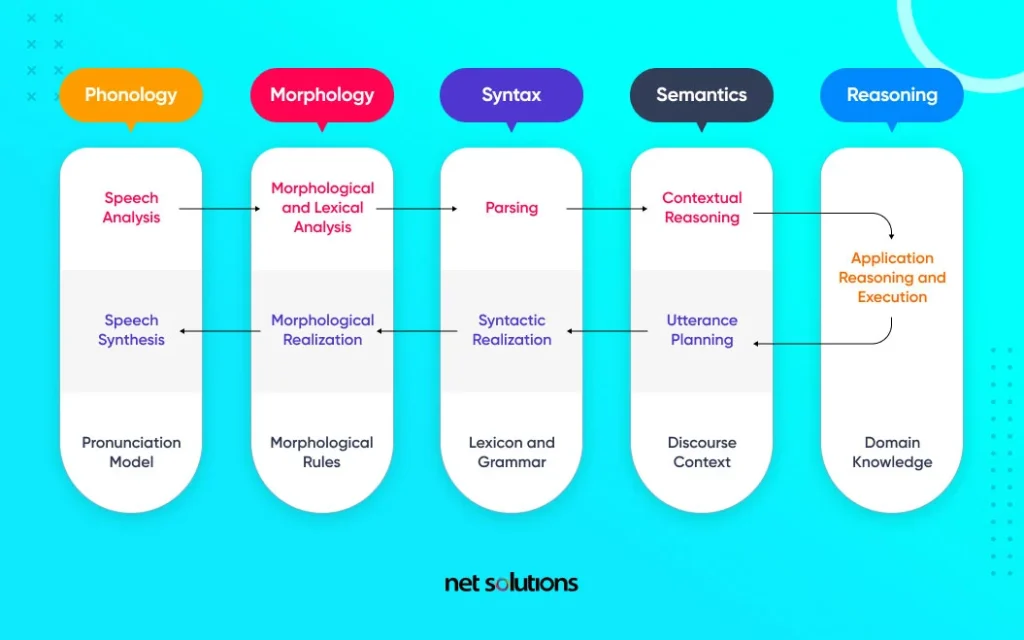
Language has always been the barrier that differentiates human beings from other species. Thousand of words can be formed from just a bunch of letters and express an indefinite number of thoughts.
For decades, scientists have dreamed of Speech recognition technology in machines that can chatter like humans. It was developed several years ago and currently exists in most PCs and search mobile devices.
- Users command the voice search device with key phrases (“ok google, Alexa, Siri”) followed by the question.
- Digital voice assistant processes and transcribes human speech into text.
- It then analyses the text, detecting questions/commands.
- Connects to external data sources such as search engines to find the relevant information.
- Translates the data into a digestible format and fulfills the user’s intent.
Importance of Voice Search in eCommerce
The rise in voice search can be a game-changer for the market. By the end of this year, half of the internet searches will happen with the help of voice search.
Overlooking voice search for eCommerce can mean losing out on the obvious opportunity. It is surprising that many marketers haven’t paid a lot of attention to this growing trend.
By 2022, 55% of all American households will own a smart speaker with voice shopping hitting $40 billion by the same year.
A voice search app or platform should be at the heart of your customer experience strategy. Here’s a list of reasons that indicate why voice search will be the future of eCommerce.
1. Offers Personalized Shopping Experience
Voice search personalizes shopping experiences with the use of recommendations based on individual preferences. For example, if a customer uses AmazonFresh to buy their daily needs and is ordering them through Alexa, the voice assistant can suggest items that match their diet based on the preferences that have been communicated to the device. And if an order has to be repeated, voice search can make the task even easier for the user.
Marketers see an average increase of 20% in sales when using personalized experiences.
2. Easy to Review
Collecting reviews hasn’t been easy for businesses but with voice search, sharing feedback is a breeze for customers. The ease and convenience of reviewing also make them more genuine and meaningful, which in turn helps the product and its several other customers. As against the time-consuming task of typing long feedbacks, voice assistants ask for specific questions and ratings, and without that hassle of having to log in.
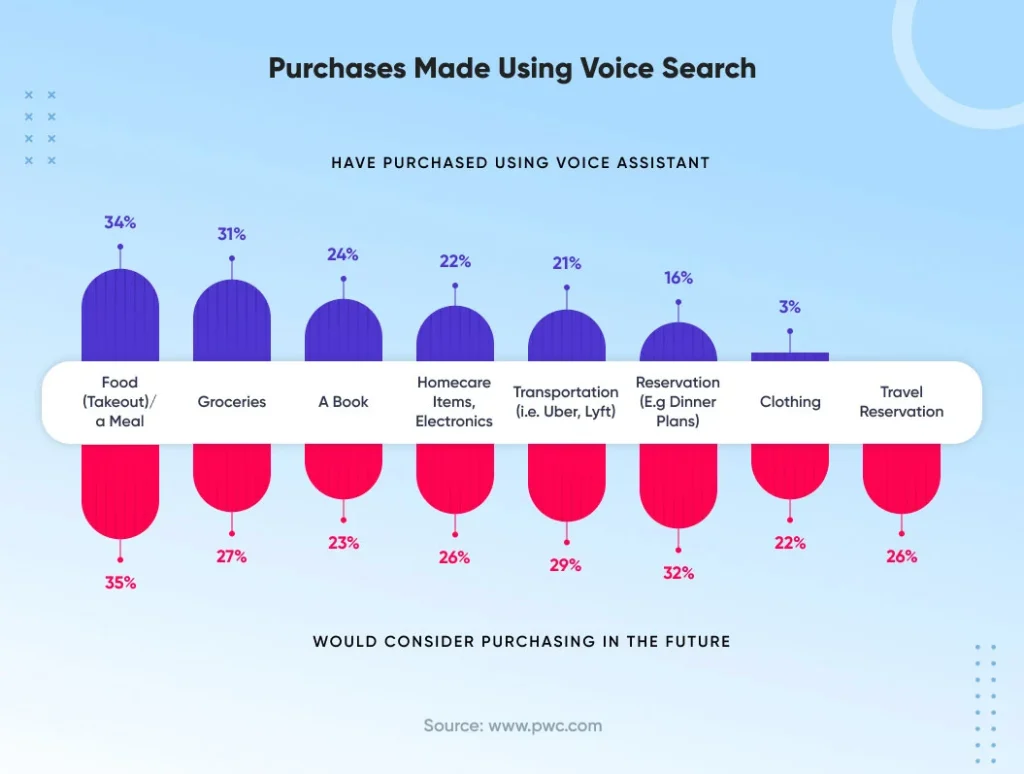
3. Time-Efficient
Voice search is quick and effective when it comes to typing a query. The average person types at the speed of around 30 to 35 words per minute, whereas a voice search can let you process close to 100 words per minute. Hence, voice search empowers you to communicate fast and obtain results more swiftly, which is an exciting feature for most users. With voice search, you can also shop on-the-go even while being engaged in another activity such as cooking or driving.
Despite being accessible everywhere, 62% of the respondents would use their voice assistant while multitasking.
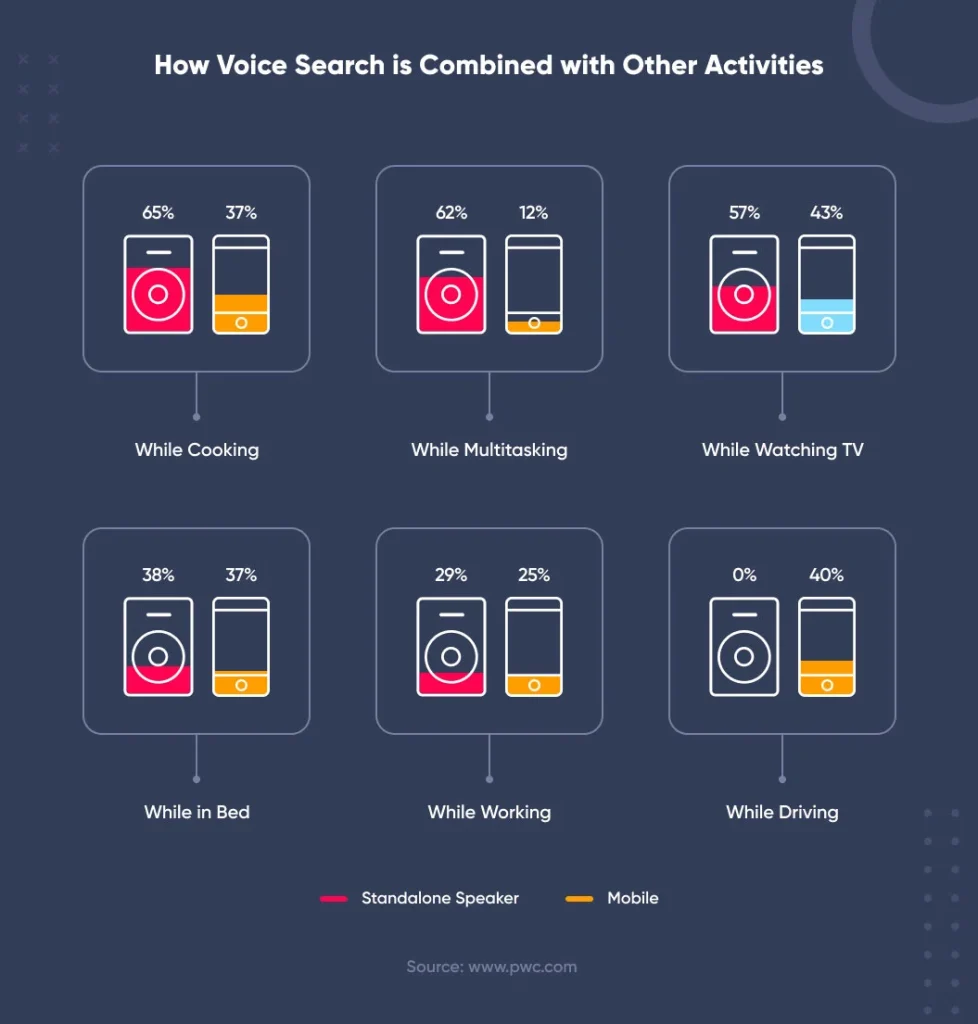
4. Enables Smart Shopping
Voice search features are not just about using voice; they are also about using artificial intelligence as well as machine learning effectively. This makes the voice feature smart enough to capture your shopping behavior and habits. For instance, when you are buying your monthly grocery online, the voice assistant can recommend and remind you about products that have previously been a part of your cart and are missing in the current list. This is a huge advantage for brands as well.
What Powered the Enormous Growth of Voice Search?
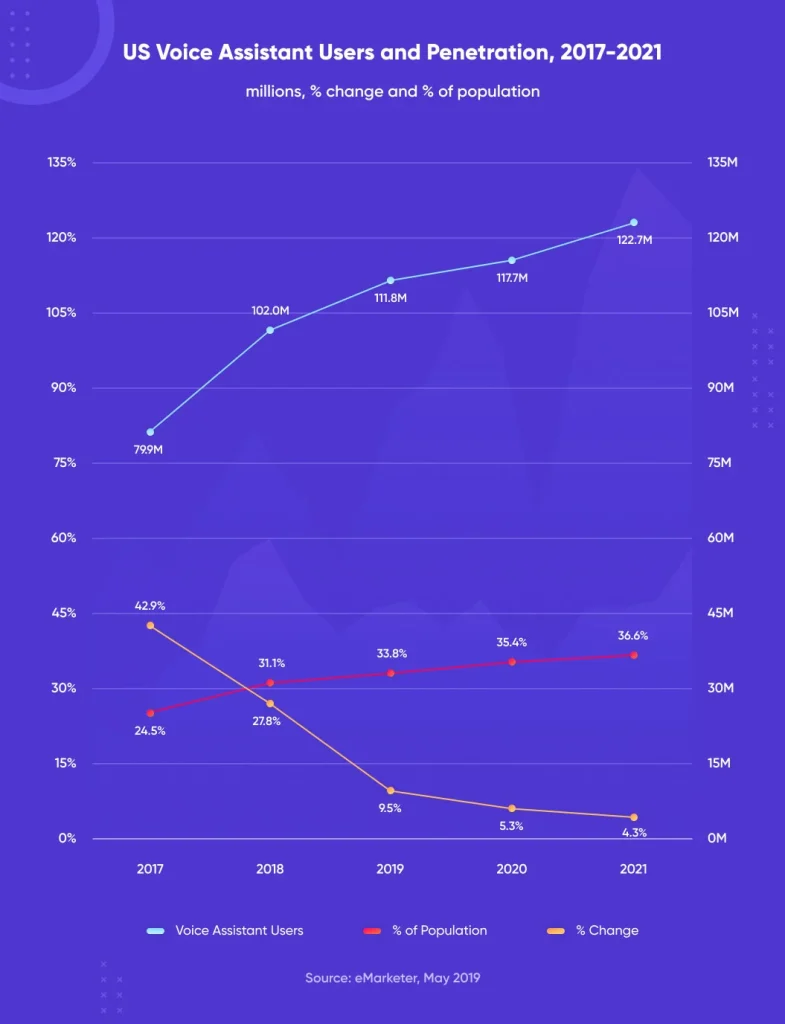
Marketers believe “voice search” is the next big thing in the digital marketing world!
Is it so?
Let’s find some stats backing the statement.
- Google search stats show that in 2013, its AI could recognize 77% of spoken words. Today, that figure is 97%.
- 51% of people who shop via voice use it to research products.
- Nearly 5.5 million US adults make purchases with their smart speakers regularly.
So what are the factors leading this industry to constant growth?
It’s simple: The charm and allurement of Voice search are undeniable!
It’s faster, hands-free, and you don’t require to stick to your device while accessing information- you multitask with it!
The evolution of technology has kept some simple features intact- high-quality service experience, user- interface, and faster accessibility.
“Voice Search” has been performing exponentially in all the above factors.
Let’s take a look at the prominent reasons for the exponential upsurge in voice search eCommerce as well.
- The design & development of voice search technology has provided a user interface that is easy to access for all age groups, which has acquired a large user base.
- With more tech giants like Amazon, Apple, Google, Samsung, and Microsoft all getting on board with Voice assistant technology in the mainstream, Voice Search has been a trustworthy digital marketing trend.
- In addition to that, the speed and convenience of searching by voice, as compared to typing, is unmatched.
The above points are the prominent reasons for the exponential upsurge in voice search eCommerce as well.
How to Optimize an eCommerce Store for Voice Search?
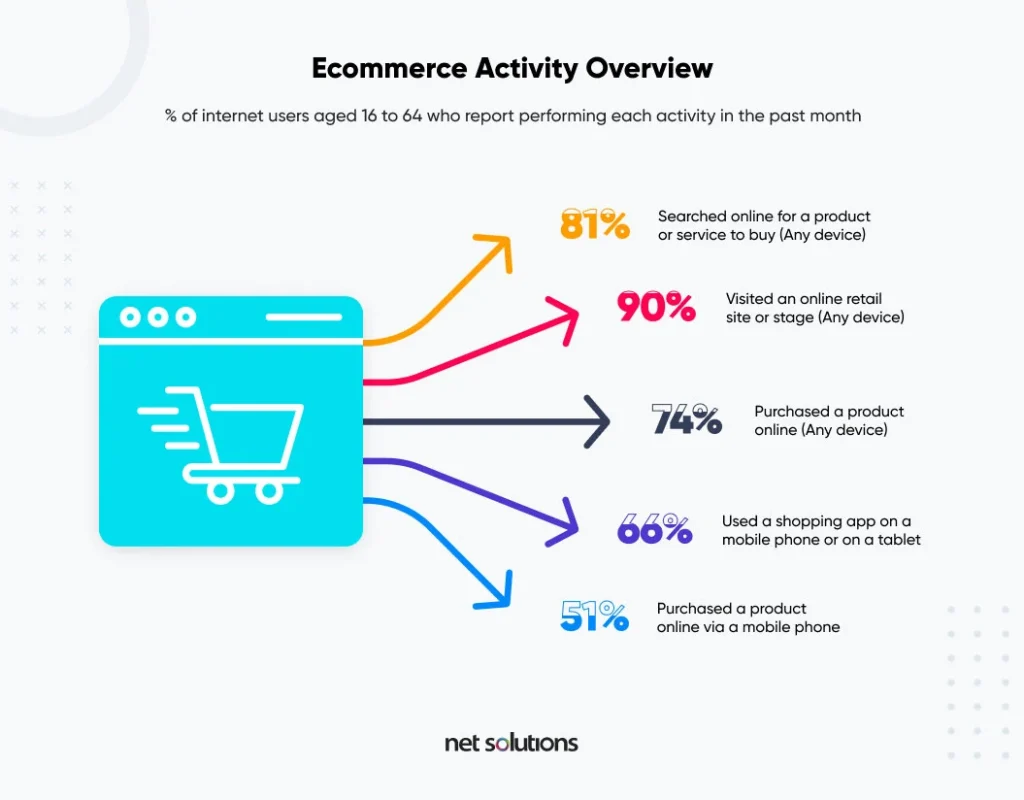
Marketing has continuously evolved alongside the evolution in technology, with more people shopping online than ever before, and a greater variety of ecommerce solutions being served to cater to customer experience.
Thus brands now, not only require to capture customer’s eyes but also customer’s ears.
Speed is a force to be reckoned with, even in search while shopping. Who wouldn’t save time by speaking instead of typing their queries into Google?
And for reaching there, optimizing content according to voice search becomes more important than ever.
1. Realign your Business with SEO Strategy
Did you get the reflex thought of why SEO? We aren’t writing a blog, are we?
Well, of course, we are not writing a blog, but we certainly have to rank on top to get customers to land on our doors.
And to reach that, optimizing SEO strategy is amongst the best you can serve your website with. Voice SEO drives higher search ranking and makes your business more searchable.
Here’s some “why” and “how.”
- The reason being Voice queries are more conversational and longer than usual “typing” search queries. While the user is “talking” to the search engine than writing down the requirement.
- The global digital experience agencies focus on “instant gratification,” and voice searches also work on the same.
The Users check the business listings rather than business websites; therefore, it is only possible with more answer-focused voice search results.
2. Prioritize Right Keywords
As we read above, answer-focused search results are essential to cater recognition amongst the users. When optimizing for voice search, the proper keyword development and utilization is necessary.
Here are some tips and hacks for keyword generation while optimizing voice search:
- Question Keywords Most of the voice searches are in the form of questions instead of phrases. The reason being, voice searches enables “talking.” So, if a user requires finding the nearest pharmacy, he would say, ” Okay, Google, Where is the pharmacy near me?” While when he types the same, he will mostly write “pharmacy near me.” These are the trigger words you shall pay special attention to. Words like “how, what, best, where, top, free, new, who, when, why, types, do, etc.” are some general trigger words commonly used, and your site must be optimized accordingly.
- Long Tail Keyword: Long-tail keywords have low search volume and thus less competition. While typing, users avoid long-tail keywords; on the other hand, with voice searches, contextual long-tail keywords are used quite often. Therefore they should have optimum use.
- Natural and Conversational: To get more impressions, it’s imperative to keep the content completely natural and conversational. This is the language people use in day-to-day conversations and prefer the exact while online voice searches.
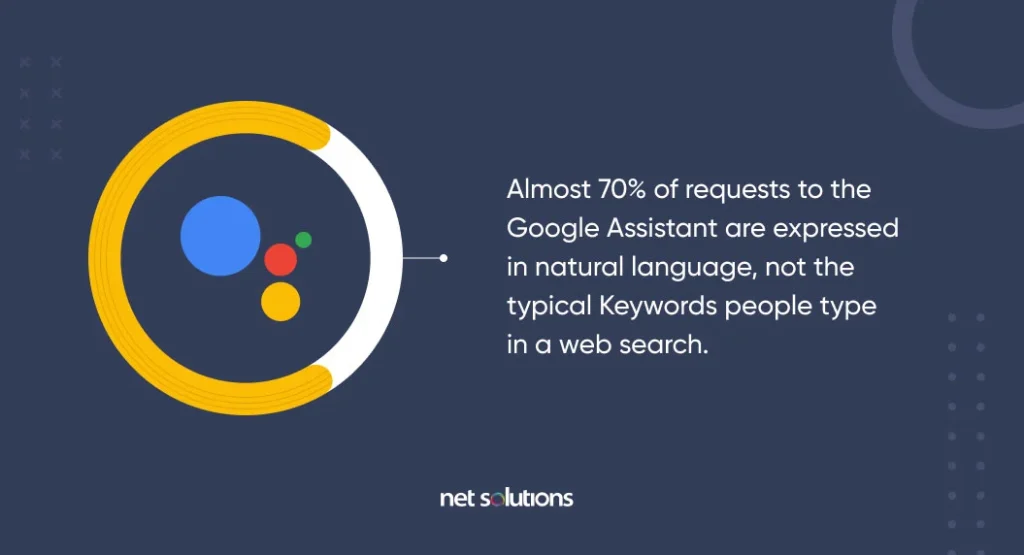
3. Optimize for Faster Page Speed
The entire ecommerce web development exercise is perhaps more about speed than anything else!
Fast loading speed improves user experience and increases user engagement in your website, leading to user purchasing.
When a user conducts a voice search, Google needs to provide a relevant answer instantly. If your page loads slowly, Google will ignore it.
Thus it’s a key feature to rank high among your competitor sites as well.
Few tips to increase site speed:
- Remove broken links
- Choose a fast web host
- Reduce the size of your images
- Reducing redirects
- Use caching
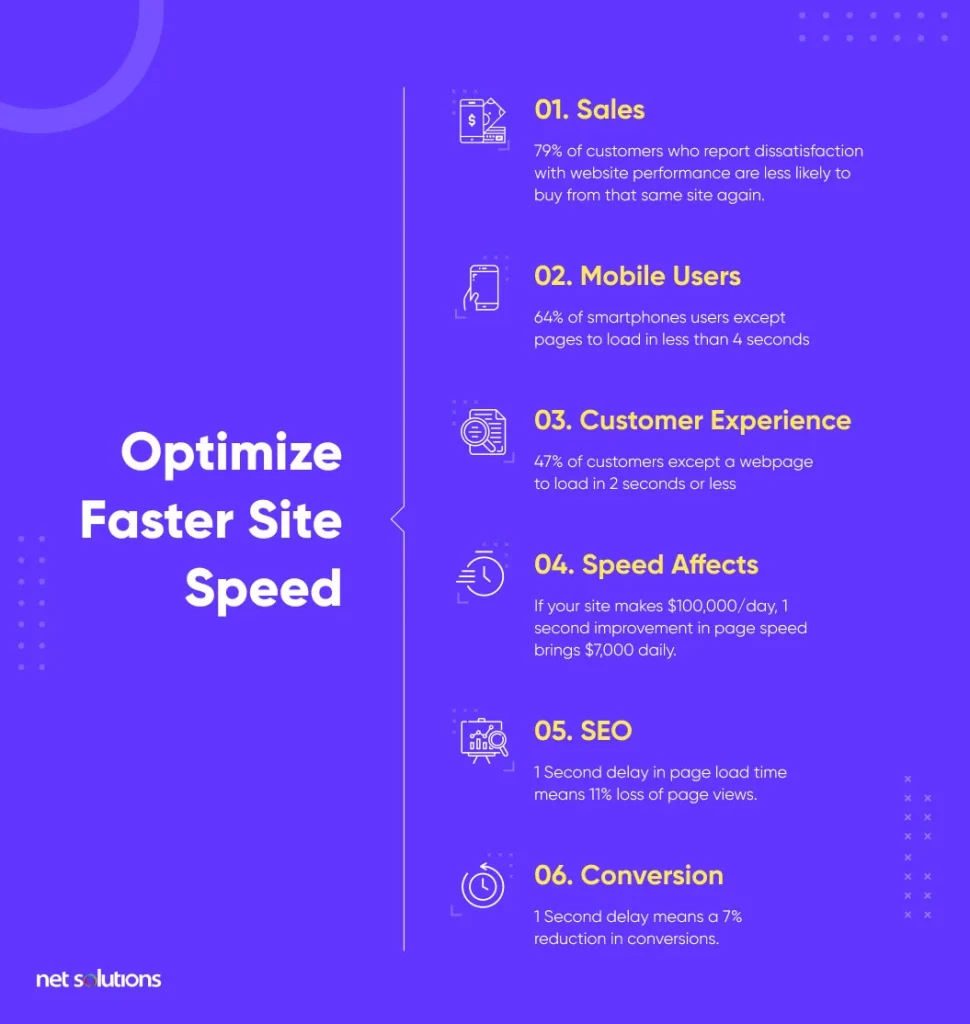
4. Responsive eCommerce Website
Mobile phones have existed for more than a decade now, and ever since, it has only kept evolving. In no near future, we see mobile phones losing their existence.
One out of every five-voice queries is conducted through mobile, says a Global Web Index.
Due to this enormous shift in how content is consumed, it’s no rocket science to understand the essence of building a mobile responsive website for your eCommerce store.
From content-driven blogs to full-scale eCommerce websites, this format is vital for every industry.
Developing a responsive mobile version of your site helps generate additional leads by creating campaigns that appeal to your desktop audience and the mobile crowd.
Did you know that in 2016 £2.6 billion was lost in revenue because customers found the checkout stage too challenging to use?
With a responsive website, you can create a website with a pleasant and enjoyable experience for your users no matter what device they choose to use.
- 73% of consumers use the internet on their mobile or tablet devices.
- 20% of companies have responsive websites.
5. Structure Your Content with a Detailed FAQ Page
It may sound weird to enlist the FAQ page in the essentials of optimizing the eCommerce Store for voice search. But let’s be honest that at some point, we have relied on FAQs to clear our heads with confusion.
Resultant, still many eCommerce websites have continued using FAQ pages redundantly.
FAQ Pages saves time for the website by enlisting the potential questions altogether, and one of the best ways to get into the customer’s heads is to create content that answers common questions.
FAQ pages boost sales since people have their fundamental doubts answered and information available, which reduces potential doubts before making a purchase.
Moreover, it increases the brand’s online visibility on Google and other search engines.
How Net Solutions Integrated Alexa Voice Search in an Application
Voice search is gaining a lot of publicity and customer’s attention, as a result, many companies are implementing it in their business model. Here’s how Net Solutions incorporated a voice search feature with an grocery shopping application.
Steps to Integrate Alexa with Your Application
- Open and create and new skill
- Define the invocation name. Ex: my test app
- Define an interactive model which consists of intents and slots
- Provide a name and a list of utterances that users would say to invoke this intent
- After you write a few utterances, note the words or phrases that represent variable information. These become the intent’s slot. Ex: I want to purchase {product}
- Define the slot type to your slot. Ex: number, food, animal, etc.
- Create a Lambda function and define intent handler for each intent
- Create a service file (optional) to interact with API Gateway
- Train you model and deploy Lambda function
- Go to “Test” section to test this skill
- Publish this skill.
Challenges
- Limited instructions: Though we can get our task done by verbal instructions easily it should be followed by certain and specific instructions. We can add any number of intents as per our requirement to hone the customer experience.
- Third-party solutions like Alexa come with challenges such as the conflict in 2 different intents, the accent of customer, etc which every voice integration platform has to address.
- An extensive list of intents: Developer has to define all possible types of intents for better customer experience even though intents are trained with machine learning algorithms to classify every possible utterance into a defined intent.
Brands That Use Voice Search to Boost Engagement
Many retail brands are making their business big with voice search features. Here are four leading brands that have effectively created their unique voice on the internet.
1. Johnnie Walker
The Scotch whiskey brand, Johnnie Walker, uses a voice search feature to offer virtual assistance that explains users about this signature whiskey and helps them build a connection with the brand. They ask users a list of questions about their preferences and then recommend a Johnnie Walker product that is most appropriate for them.
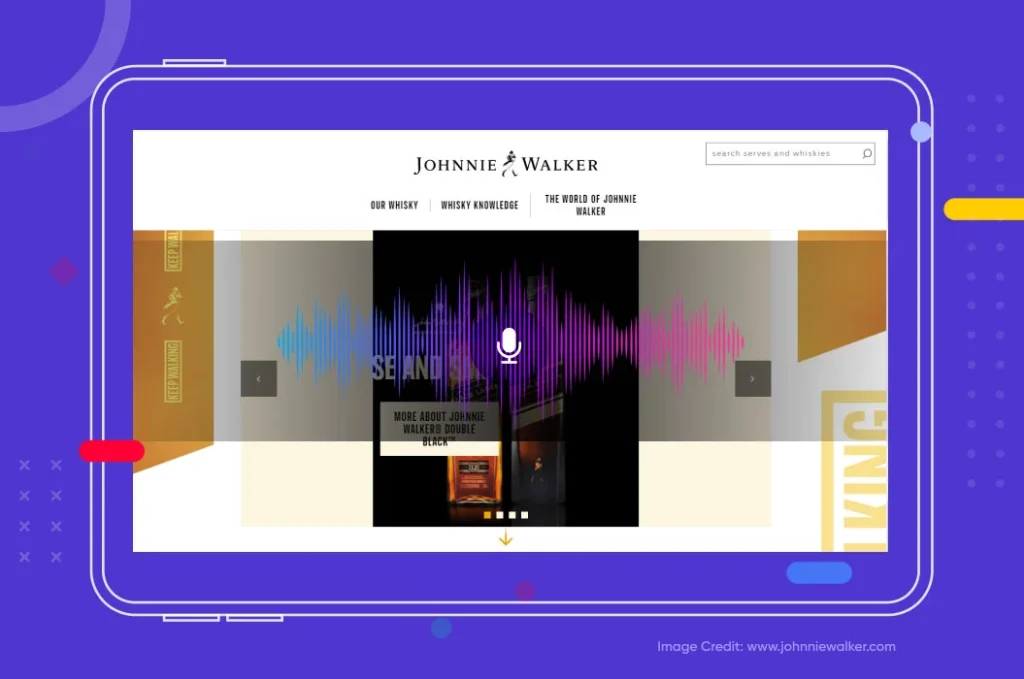
2. Nestlé
In 2017, this global brand launched its GoodNes Alexa skill. It offers a visual voice browsing experience to the customers who love cooking. The Alexa device helps customers enhance their culinary skills with voice and visual guidance. GoodNes offers a visual guide that runs on Safari or Chrome on both desktop and mobile devices.
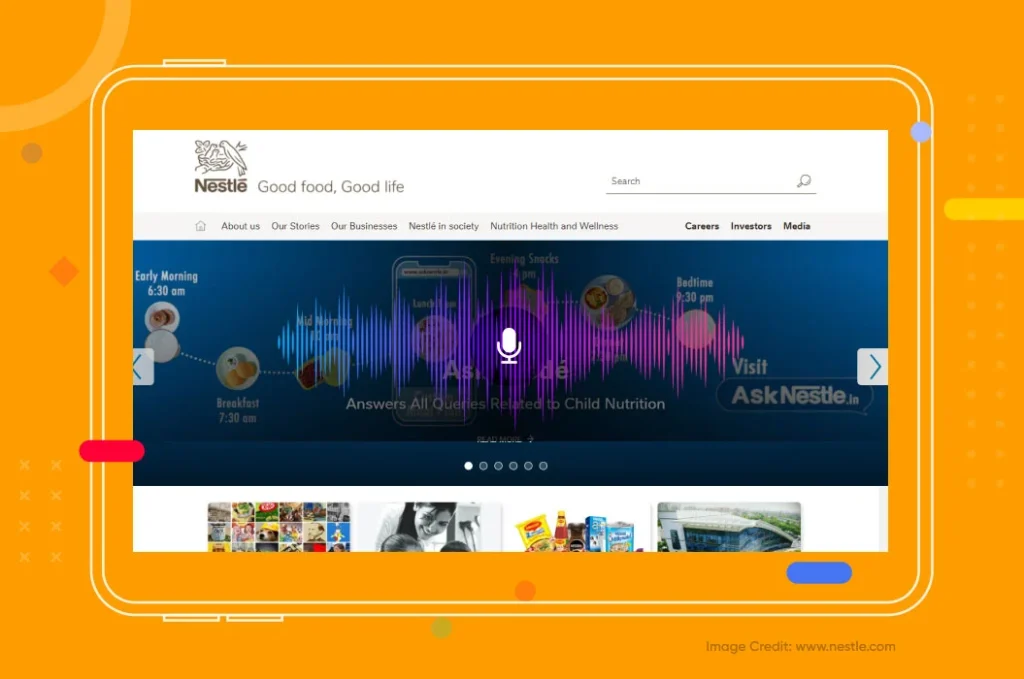
3. Domino’s
Domino’s pizza rolled out a voice assistant feature Dom for automating pizza orders over the phone to ensure that the process is convenient and quick for customers. It takes orders from the users and checks their order status as well. This is in fact, a part of Domino’s strategy to go 100% digital in the near future.
4. Patrón Tequila
The tequila brand partners with several virtual assistants, including Amazon Alexa and the Google voice search device, to bring it’s Patron Cocktail Lab recipes, how-to videos, tips, and recommendations to their target audience through expert bartenders via voice activation.
Patrón has even introduced its AI-enabled chatbot known as Bot-tender. This tool suggests cocktail recipes and ideas to customers on social media messengers like Twitter and Facebook.
5. Burger King
Now that we are talking innovation here, Burger King had to stand the list.
“OK, Google, what is the Whopper burger?” was the phrase that made headlines when it launched a 15-second television spot.
While not being able to differentiate between consumer’s voices and television audio, Google Home devices started informing the listeners about Burger King’s Whopper burger. While an excellent stunt, Burger King’s strategy worked wonders, and the campaign went like wildfire as the company found an entirely new way to capitalize on voice search technology.
Conclusion
The constant growth of eCommerce business shows that the customers’ preference for online shopping is here to stay. While users love to explore their options on the internet and buy what they need without visiting a store, the introduction of voice search has entirely redefined the shopping experience.
Figures show that voice commerce sales will hit $40 billion by 2022. This depicts how voice search will change the future of eCommerce and create opportunities for online retailers. Hence, businesses must actively look for voice search optimization to rank better and augment their digital presence.
SHARE THIS POST
Table of Contents
Related Resources
- eCommerce App Development Cost: Budgeting In-Depth Guide
- 13 Differences Between B2B and B2C eCommerce Websites
- Top 10 eCommerce Challenges and Easy Ways to Overcome Them
- 3 Types of eCommerce Business Models That Work in 2025
- eCommerce for Business: Is eCommerce Applicable for All Business Types
- eCommerce Customer Journey Mapping - The Secret to Higher Conversion Rates
- What is Headless Commerce? The Ultimate Guide
- Top 15 eCommerce KPIs to Track the Performance of Your Online Business
- Why Your Business Needs a Mobile eCommerce App
- Omnichannel Retail Strategy: A Comprehensive Guide
- Omnichannel vs Multichannel Retailing: The Complete Guide
- What is eCommerce Order Fulfilment? (And 6 Steps to Improve the Process)
- PCI Compliance: Everything You Need To Know
- The BEST Guide to eCommerce Personalization
- 12 Essential Factors for Choosing the Best eCommerce Platform
- The Ultimate Guide to Product Information Management (PIM) Systems for Ecommerce
- What is a Product Recommendation Engine (And How it Helps Boost Sales)
- eCommerce Replatforming: Challenges, Benefits, and Best Practices
- The Ultimate Guide to eCommerce Security
- Top 13 eCommerce Trends in 2025
- What is Web Accessibility (And Why it Matters for Your eCommerce Business)


